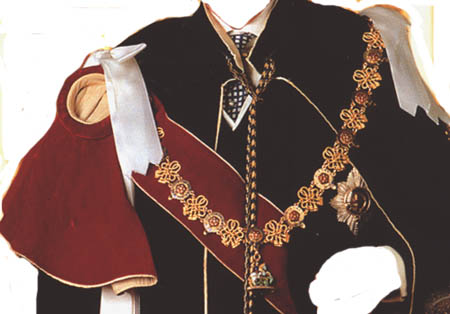

The Order of the Knight of the Garter
Written and researched by: Margaret Odrowaz-Sypniewska, B.F.A.

The Order of the Knight of the Garter was established at the onset of the 100 Years War between England and France, on St. George's Day, April 23, 1348. Edward III (1312-1377) conceived that the Order would be made up of twenty-six close companions, which would include the king and the Prince of Wales. The Garter is the symbol for one of the oldest and most senior orders of chivalry. The Order's inspiration was the legendary King Arthur and the Round Table. As early as 1344, seventeen (17) years after succeeding to the throne, Edward III proclaimed that a new Round Table of Knights would be all be mustered for jousting tournaments.
As a side note, four years later, in 1348, The Black Death came from China and killed one-third of the population of Europe.
The symbol of the Order is a blue garter marked with the motto: Honi soit qui mal y pense. Blue was the French Royal Color. The legend is that Joan, the Countess of Salibury, attended a ball given by the King at Windsor Castle to celebrate the fall of Calais. While Edward was dancing with his cousin, Joan, her blue garter came loose and fell to the floor. The audience laughed to her embarassment and then Edward III picked it up and tied the garter on his own leg, and spoke: "Evil be to him who think evil," (the translation of their motto above). He also said that the garter represented such an honor that only the most worthy of his subjects would receive it.
You see, the garter was also a symbol of membership in a witches' coven. So the story goes that Edward did not wish to have people think that the Countess was a witch.
Dr. Margaret Murray believed that all the Plantagenets were witches. She said Edward III founded two covens. The incident about the Countess of Salisbury's blue garter is significant since it WAS a symbol of witchcraft. Edward III's actions were to let Lady Salisbury know that her secret of her witch-hood was safe with him, because he himself was a priest of a coven.
The garter could only be given upon the death of one of the king's twenty-four Knights. The Tudors were said to have used The Order of the Garter as a tool to win foreign political alliances. Henry VIII's anger often was an embarrassment to his Knights, especially those he no longer held in favor. He would take his knights to St. George's Chapel and order his heralds to kick the "treasonable knight's" banner, sword, and helm out of the gates of the Chapel and into the ditch. No doubt this was not a task they enjoyed, and it certainly made Henry no points in popularity
Henry VIII had been a Knight of the Garter since the age of four. Every year on April 23rd, Henry held a chapter meeting of the Order. During the thirty-seven years of his reign, twenty-four chapter meetings were held at Greenwich. In 1510, Henry decreed that: the collar of the Order should consist of twelve Tudor roses set within blue garters with twelve tasselled knots. These were to hang from a jewelled pendant of St. George. In 1521, Henry instituted a smaller pendant for everyday use. Henry gave Francis I the Order of the Garter, and received the Golden Fleece from Francis in 1505.
The fact that Henry VIII gave his illegitimate son Henry Fitzroy the Order of the Garter tells us that he thought of him as his legitimate heir to the throne at the time. He made no secret that Henry, Jr. was his son, yet he denied that any of Mary Boleyn's children were his. No king or Prince of Wales has ever been painted without his Garter Collar, and Queen Anne was the first British Queen to wear the Badge and Riband on all ceremonial occasions.